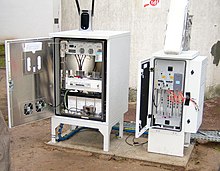This article has multiple issues. Please help improve it or discuss these issues on the talk page. (Learn how and when to remove these messages)
|
 |

Worldwide Interoperability for Microwave Access (WiMAX) is a family of wireless broadband communication standards based on the IEEE 802.16 set of standards, which provide physical layer (PHY) and media access control (MAC) options.
The WiMAX Forum was formed in June 2001 to promote conformity and interoperability, including the definition of system profiles for commercial vendors.[1] The forum describes WiMAX as "a standards-based technology enabling the delivery of last mile wireless broadband access as an alternative to cable and DSL".[2] IEEE 802.16m or WirelessMAN-Advanced was a candidate for 4G, in competition with the LTE Advanced standard.
WiMAX was initially designed to provide 30 to 40 megabit-per-second data rates,[3] with the 2011 update providing up to 1 Gbit/s[3] for fixed stations.
WiMAX release 2.1, popularly branded as WiMAX 2+, is a backwards-compatible transition from previous WiMAX generations. It is compatible and interoperable with TD-LTE. Newer versions, still backward compatible, include WiMAX release 2.2 (2014) and WiMAX release 3 (2021, adds interoperation with 5G NR).
- ^ Pinola, Jarno; Kostas Pentikousis (2008). "Mobile WiMAX". The Internet Protocol Journal. Cisco. Archived from the original on 2016-08-21. Retrieved 2016-08-05.
- ^ "WiMax Forum – Technology". Archived from the original on July 22, 2008. Retrieved 2008-07-22.
- ^ a b Carl Weinschenk (April 16, 2010). "Speeding Up WiMax". IT Business Edge. Archived from the original on 2011-09-05. Retrieved August 31, 2011.
Today the initial WiMax system is designed to provide 30 to 40 megabit-per-second data rates.